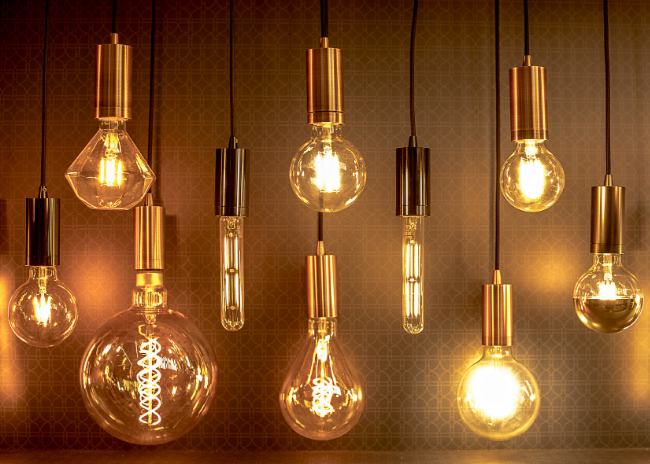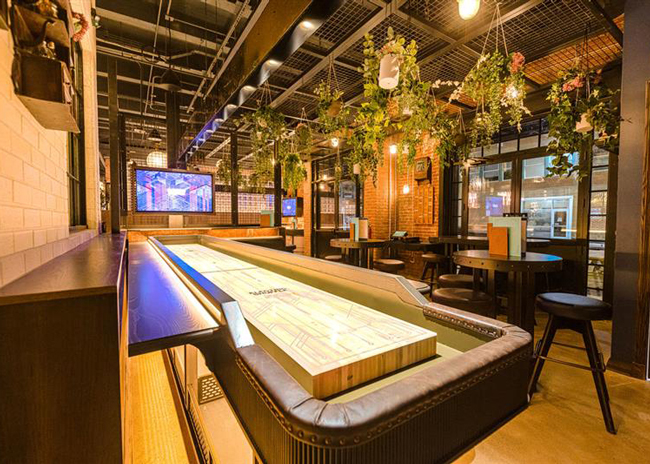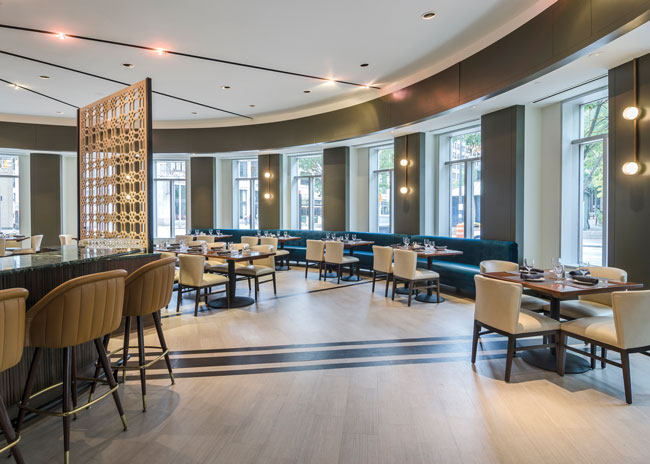In the front of the house, lighting is primarily for illuminating, but it also plays a big part in creating a restaurant’s overall atmosphere. It is a functional aspect of the decor.
Although LED lighting was created in 1962, it has only recently become widely used commercially. LEDs enable designers to accomplish more and create dramatic effects with a single light source. LED lighting also offers improved energy efficiency, lower heat emittance, increased brightness and a longer lifespan.
The type of operation dictates the lighting. While fast moving, informal quick-service or fast-casual environments tend to utilize higher illumination levels, fine dining is more likely to have a toned-down candlelit setting.
Rules of Thumb
There are many variables that dictate the type of lighting as well as the number and style of fixtures needed. The ceiling height, total square footage of the room and furniture’s scale should be factored in.
Each FOH area may have different requirements. For example, lights used over tables will be different than what’s needed in the bar area. Commercial table lighting is installed 6 to 12 inches higher than residential lights, which average 30 inches. It typically consists of a softer, diffused glow that is flattering to patrons and provides good menu visibility. Bar lighting height is generally no less than 42 inches.
Placement and line of sight are key. Hanging light fixtures should not obstruct key visual elements like menu boards, decor or signage. Lighting also can be used as a marketing tool, drawing customers’ attention to a point of sale area or specific products. Lit up front windows can show off the energy and animation of a space to beckon potential customers walking or driving by.
When selecting decorative lighting, consider the scale and number of fixtures. Zones can be built that incorporate decorative lighting. Because LED lights are available in many different formats, tiny objects or large surfaces can be highlighted. Unique lighting schemes also can be created and add to the ambience. Entire ceilings can be accentuated via up lighting. Also, when a pattern of tiny lights in groupings illuminate an entire area, an architectural effect on ceilings and walls is produced. With LEDs’ wide range of size and output, lighting can be integrated into a restaurant’s architecture like wall panels or take on unique forms and shapes.
In choosing a lighting fixture, lumens or total brightness is a consideration as well as placement. Foot candles refer to the lighting intensity on a surface of interest and impact both contrast and differentiation. Accents and shadows add drama to a space.
The higher the light, the more it will spread out to encompass what’s beneath it, including the tabletop and floor. Look at the beaming or how far light is spreading when from the source. While a spotlight may have just 15% beaming and be more concentrated, a floodlight typically projects 50% beaming.
For spaces that are open, like a food hall, brighter lighting with cans or tracks may be called for. Pendant clusters work best above community tables when situated 6 to 12 inches in from the long sides and a couple inches in from the short sides, so these are well-centered over the table. These lights should be accentuating the food, not the customers. With intimate spaces, pendants, cove lighting and decorative fixtures are more appropriate.
Color & Temperature
There are different aspects to lighting. Lumens is a measure of how much light is emitted from a bulb. The higher the lumens, the brighter the light.
A kelvin rating refers to lighting’s overall hue. A lower kelvin rating of 2700 is candlelit compared with 6000 to 10000, which is a bluish-white crisp hue akin to daylight that provides higher visibility. While a kelvin lighting rating of 5000 makes ice used for chilling beer look crisp and cold, it would not be appropriate for beef that’s on display, which would require a less harsh and more flattering lower kelvin rating.
Relatedly, color rendering index or CRI measures how accurately an artificial light source reproduces the color of a material. The index goes up to 100, and the higher the number, the more accurate the color of the object being lit will be. It’s important to note that the higher the CRI, the more expensive the light source because it provides a true representation of colors. This rating also is impacted by the type of lighting. Fluorescent bulbs have poor CRI, which doesn’t accurately reproduce red hues. Kelvin ratings above 2700 tend to create bluer lighting with a harsher coloring.
Restaurant operators looking to change their lighting’s intensity during different dayparts and conserve energy can take advantage of dimmers. Incandescent or halogen lighting dimmers work with the filaments inside the bulbs, but fluorescent lights need dimming ballasts. Not all LED lights are dimmer compatible, and most require special switches for this feature.
Aesthetics
Decorative lighting brings personality to a space and allows for more creativity. It should conform to the space and atmosphere.
Material helps set the mood. Metal shades produce a strong silhouette and transmit light differently than glass fixtures, which are less noticeable in harsher lighting or daylight. Natural materials and pierced shades allow visibility of the light source, produce a silhouette and add sparkle in the evening.
Fixtures that have integrated LED lights provide a variety of shapes, such as squares, rounds and ribbons that can highlight wall art or architecture. It’s recommended that spare lights be purchased for the future in case the fixture is no longer available when replacement is needed.
Lighting also changes the atmosphere using color spectrums and intensities. Faux daylight can be transmitted through backlit frosted panels and direct downlighting over an area creates a sense of light over light. Custom chandeliers integrating LED lighting have become more prevalent. Up lit glass can showcase top shelf liquor and highlight multiple colors.
Lighting can designate a service point with drop down pendants or be used to draw customers’ eyes to specific areas, signage or products. By the same token, light sources can be completely obscured, with just the illumination displayed to wash a wall or spot with light for effect.
Trends
With lighting, it’s easier to stay on trend because fixtures can be affordably and quickly changed out and refreshed when needed.
Industrial fixtures have remained popular due to being versatile and affordable.
Recently, natural and woven fibers have become more prevalent, in line with the popularity of rattan furniture. Retro with a modern spin is popular, as are hand-made artisan fixtures. Many operators are moving toward minimalistic, simple yet sleek fixtures that are understated with clean lines. This includes metal, glass and frosted shades that let measured amounts of light through.
New lighting fixtures are textured, translucent, patterned or a combination. It’s possible to get creative using objects rather than traditional fixtures as lighting vehicles.
Counter or table lighting with a residential feel is being incorporated more often as are sconces as innovative ways to incorporate lighting into a space.




